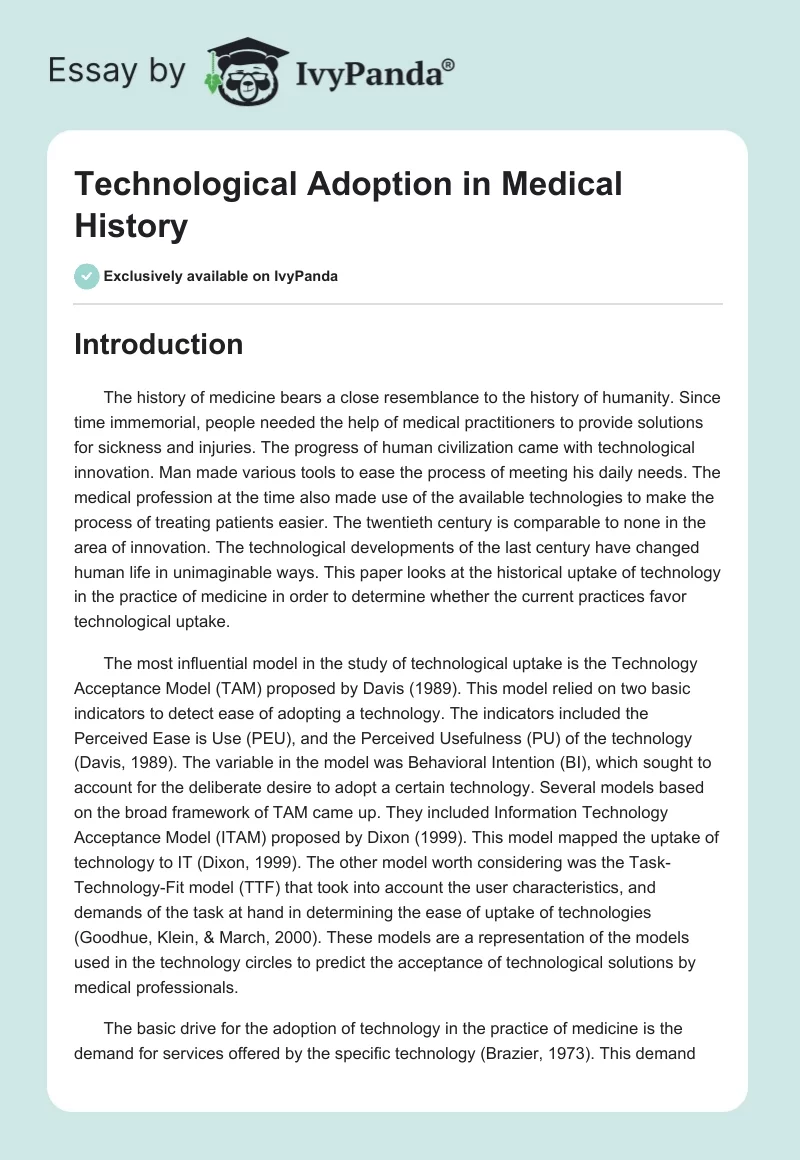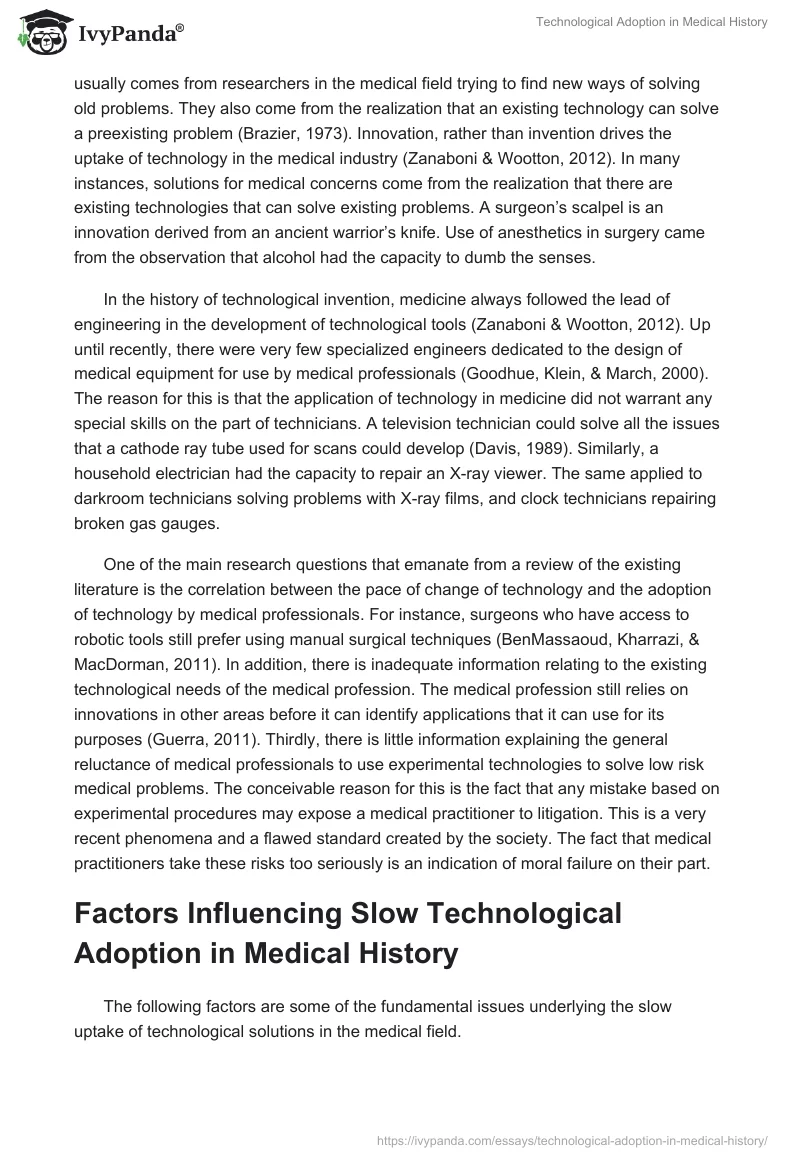- Introduction
- Factors Influencing Slow Technological Adoption in Medical History
- Risk Averseness by Medical Practitioners
- Misplaced Moral Questions
- Lack of Medical Engineers
- The Future of Technology in Medicine
- Proactive Pursuit of Technological Solutions
- Encouraging Shop Floor Innovation
- Change of Attitude by Medical Practitioners
- References
Introduction
The history of medicine bears a close resemblance to the history of humanity. Since time immemorial, people needed the help of medical practitioners to provide solutions for sickness and injuries. The progress of human civilization came with technological innovation. Man made various tools to ease the process of meeting his daily needs. The medical profession at the time also made use of the available technologies to make the process of treating patients easier. The twentieth century is comparable to none in the area of innovation. The technological developments of the last century have changed human life in unimaginable ways. This paper looks at the historical uptake of technology in the practice of medicine in order to determine whether the current practices favor technological uptake.
The most influential model in the study of technological uptake is the Technology Acceptance Model (TAM) proposed by Davis (1989). This model relied on two basic indicators to detect ease of adopting a technology. The indicators included the Perceived Ease is Use (PEU), and the Perceived Usefulness (PU) of the technology (Davis, 1989). The variable in the model was Behavioral Intention (BI), which sought to account for the deliberate desire to adopt a certain technology. Several models based on the broad framework of TAM came up. They included Information Technology Acceptance Model (ITAM) proposed by Dixon (1999). This model mapped the uptake of technology to IT (Dixon, 1999). The other model worth considering was the Task-Technology-Fit model (TTF) that took into account the user characteristics, and demands of the task at hand in determining the ease of uptake of technologies (Goodhue, Klein, & March, 2000). These models are a representation of the models used in the technology circles to predict the acceptance of technological solutions by medical professionals.
The basic drive for the adoption of technology in the practice of medicine is the demand for services offered by the specific technology (Brazier, 1973). This demand usually comes from researchers in the medical field trying to find new ways of solving old problems. They also come from the realization that an existing technology can solve a preexisting problem (Brazier, 1973). Innovation, rather than invention drives the uptake of technology in the medical industry (Zanaboni & Wootton, 2012). In many instances, solutions for medical concerns come from the realization that there are existing technologies that can solve existing problems. A surgeon’s scalpel is an innovation derived from an ancient warrior’s knife. Use of anesthetics in surgery came from the observation that alcohol had the capacity to dumb the senses.
In the history of technological invention, medicine always followed the lead of engineering in the development of technological tools (Zanaboni & Wootton, 2012). Up until recently, there were very few specialized engineers dedicated to the design of medical equipment for use by medical professionals (Goodhue, Klein, & March, 2000). The reason for this is that the application of technology in medicine did not warrant any special skills on the part of technicians. A television technician could solve all the issues that a cathode ray tube used for scans could develop (Davis, 1989). Similarly, a household electrician had the capacity to repair an X-ray viewer. The same applied to darkroom technicians solving problems with X-ray films, and clock technicians repairing broken gas gauges.
One of the main research questions that emanate from a review of the existing literature is the correlation between the pace of change of technology and the adoption of technology by medical professionals. For instance, surgeons who have access to robotic tools still prefer using manual surgical techniques (BenMassaoud, Kharrazi, & MacDorman, 2011). In addition, there is inadequate information relating to the existing technological needs of the medical profession. The medical profession still relies on innovations in other areas before it can identify applications that it can use for its purposes (Guerra, 2011). Thirdly, there is little information explaining the general reluctance of medical professionals to use experimental technologies to solve low risk medical problems. The conceivable reason for this is the fact that any mistake based on experimental procedures may expose a medical practitioner to litigation. This is a very recent phenomena and a flawed standard created by the society. The fact that medical practitioners take these risks too seriously is an indication of moral failure on their part.
Factors Influencing Slow Technological Adoption in Medical History
The following factors are some of the fundamental issues underlying the slow uptake of technological solutions in the medical field.
Risk Averseness by Medical Practitioners
Medical practitioners operate in a high-risk environment. The fate of patients is in their hands. Any mistake on their part can lead to loss of life, or permanent consequences for the patient. In addition, many patients are quick to consider litigation whenever they believe a medical practitioner did not administer treatment as required (DiMatteo, 1998). These risks force medical practitioners to standardize their operations and to use well-established methods in the treatment of patients. The result is that none of them is willing to try out new methods. They can only do this if there is sufficient cover from their hospitals, and with approvals from regulators. The argument here is not for rogue action by medical professionals. It is for an entrepreneurial approach to medicine to advance the trade. This aversion to risk by medical practitioners is doing more harm than good because a medical practitioner feels safer sticking to the old treatment methods than trying out new approaches to solve emerging problems.
Misplaced Moral Questions
Misplaced moral questions also hinder the uptake of technology by medical practitioners. Medical practitioners inevitably face many moral dilemmas in their work. However, this reality should not be an excuse to create moral arguments regarding technology. A medical practitioner may argue that it is not morally defensible to pursue certain lines of treatment because of unspecified consequences.
The entire process that a new drug must go through before acceptance as a standard treatment is evidence of the moral dilemma facing the medical industry. The regulators worry that any new medicine can be poisonous hence the requisite medical tests to determine its side effects before approval for widespread dispensation. This process is entirely understandable. The problem is applying the same standard to technological issues. Usually technological solutions have better predictability. It is much easier to institute controls. For instance, the use of electronic health records does not need to be a moral question. However, some practitioners question the morality of the health records based on the risks a patient may suffer if there is a breach in the IT systems (Guerra, 2011). When medical practitioners approach technology with misplaced moral questions, the result is a slower uptake of technology. A decision such as the use of robot-assisted surgical techniques must emanate from the best interests of the patient (BenMassaoud, Kharrazi, & MacDorman, 2011). There is no benefit to the patient when the surgeon starts considering the morality of that decision.
Lack of Medical Engineers
Thirdly, slow uptake of technology in medical history is the direct result of very few technical professionals dedicated to the medical industry. The medical industry has not benefited from shop floor innovation simply because it does not have enough technical innovators within medical facilities. Many of the technical personnel in hospitals and medical centers are equipment operators.
The medical industry is famous for innovations in biotechnology and advances in molecular science. However, these technologies rely on platforms that engineers in other fields create (Larkley & Maynhard, 2008). For instance, the development of the refrigerator did not come from the demands of medicine. Rather, the medical industry found that vaccines could last longer when stored in refrigerators. Similarly, the cathode ray tube did not come from the medical industry. The medical industry discovered that these tubes could help in tracking a patient’s pulse rate. The recent increase in the number of medical engineers should lead to greater technological innovation in the medical industry.
The Future of Technology in Medicine
The future of technology in medicine relies on several factors. These factors take into account that the medical industry is already making several efforts to meet the demands placed on it by technological change.
Proactive Pursuit of Technological Solutions
It is time that the medical industry took charge of its technological development. In the area of IT, the medical industry needs standards relating to Electronic Health Records (Guerra, 2011). The standards should come from the medical industry and not software companies. When it comes to technology, the medical industry needs to shift from its current “client mentality” in order to take leadership and ownership of its technological destiny.
Encouraging Shop Floor Innovation
If all medical facilities embrace shop floor innovation in the provision of services, then the industry will have a clearer picture of its technological needs. Shop floor innovation in medical facilities can lead to a revolution in the way any hospital offers services. Allowing doctors, nurses, and medical specialists some leeway in their approach to medicine will bring about new solutions to some age old problems. In the same vein, innovation is not the preserve of laboratories (Larkley & Maynhard, 2008). People on the shop floor are the best innovators because of their clear understanding of the operations at the shop floor.
Change of Attitude by Medical Practitioners
Finally, a change of attitude by medical practitioners can help with the uptake of technology (Ulmer, 2010). If medical practitioners demonstrate enthusiasm towards technological solutions, then innovators will have greater morale in pursuing solutions for the medical industry. Perhaps medical curriculums need to include innovation as a core subject to make innovation more acceptable in the medical industry.
References
BenMassaoud, C., Kharrazi, H., & MacDorman, K. F. 2011. Facilitators and Barriers to Adopting Robotic-Assisted Surgery: Contextualizing the Unified Theory of Acceptance and Use of Technology. Plos One , 6 (1), 10-12.
Brazier, M. A. 1973. From Calculating Machines to Computers and their Adoption by the Medical Sciences. Medical History , 17 (3), 135-245.
Davis, F. D. 1989. Perceived Usefulness, Perceived Ease of Use, and User Acceptance of Information Technology. MIS Quaterly , 13 (3), 318-340.
DiMatteo, R. M. 1998. The Role of the Physician in the Emerging Healthcare Environment. Western Journal of Medicine , 168 (5), 328–333.
Dixon, D. R. 1999. The Behavioral Side of Information Technology. International Journal of Medical Informatics , 56 (10), 117-123.
Goodhue, D. L., Klein, B. D., & March, S. T. 2000. User Evaluations of IS as Surrogates for Objective Performance. Information and Management , 38 (10), 87-101.
Guerra, A. 2011. EMR Problems Hurt Doctor Efficiency, AMA Says.Information Week. Web.
Larkley, J. E., & Maynhard, V. B. 2008. Innovation in Technology. New York, NY: Nova Publishers.
Ulmer, C. 2010. Future Directions for the National Healthcare Quality and Disparities Reports. Washington DC: National Academies Press.
Zanaboni, P., & Wootton, R. 2012. Adoption of Telemedicine: From Pilot Stage to Routine Delivery. Medical Information Decision Making , 12 (1), 1.


